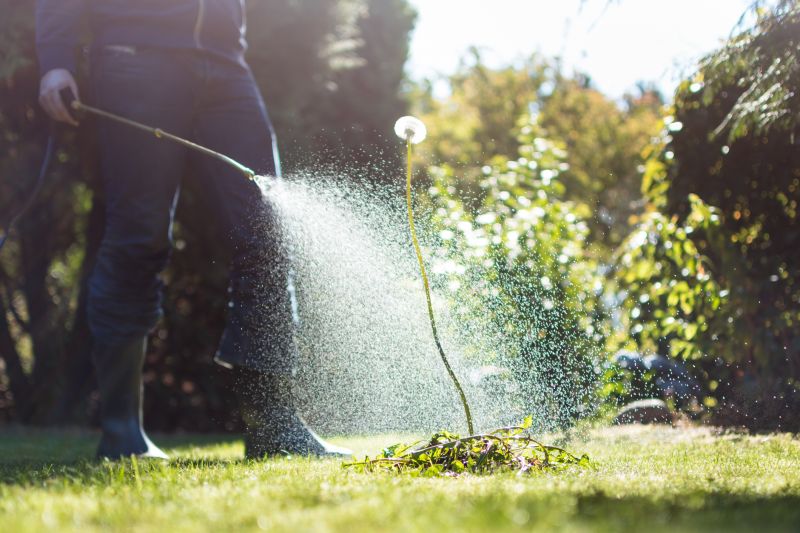Favorite Poison Hemlock Control Products For Homeowners
A curated selection of popular products that make poison hemlock removal simple and effective for homeowners and gardeners.
 Poison hemlock is a highly invasive plant that can pose serious health risks to humans and animals if not managed properly. Effective removal requires the right tools and products to ensure safe and thorough eradication. Whether dealing with small patches or larger infestations, selecting appropriate products can help control this toxic plant efficiently. It is important to understand the different removal methods and the variety of products available, including herbicides, manual tools, and protective gear, to tailor your approach to the specific situation.
Poison hemlock is a highly invasive plant that can pose serious health risks to humans and animals if not managed properly. Effective removal requires the right tools and products to ensure safe and thorough eradication. Whether dealing with small patches or larger infestations, selecting appropriate products can help control this toxic plant efficiently. It is important to understand the different removal methods and the variety of products available, including herbicides, manual tools, and protective gear, to tailor your approach to the specific situation.
Top Overall Option
Herbicide Spray for Tough Weeds
A versatile herbicide spray designed for targeted application on invasive plants like poison hemlock. It offers precise control with easy-to-use spray mechanisms, allowing users to treat individual plants without affecting surrounding vegetation. Proper application and protective gear are recommended to ensure safety during use.
Types of Products For Poison Hemlock Removals
Herbicide Concentrates
Highly concentrated formulas that require dilution before application, suitable for large infestations and professional use.
Ready-to-Use Herbicide Sprays
Pre-mixed sprays that are convenient for spot treatment and small patches of poison hemlock.
Manual Weed Pullers
Tools designed to remove plants by the root, minimizing chemical use and suitable for smaller infestations.
Long-Handled Pruners
Tools that help reach and cut poison hemlock at ground level, reducing the need for bending or close contact.
Protective Clothing and Gloves
Specialized gear to prevent skin contact with toxic plants and chemical treatments during removal.
Herbicide Foam
Foam formulations that adhere to the plant's surface, providing targeted treatment with minimal runoff.
Soil Drench Solutions
Liquid products designed to saturate the soil and prevent regrowth from roots.
Biological Control Agents
Natural predators or pathogens that can help manage poison hemlock populations over time.
Herbicide Granules
Granular formulations that can be applied directly to the soil or plant base for targeted control.
Vegetation Barriers
Physical barriers to prevent the spread of poison hemlock seeds and seedlings.
Spot Treatment Pens
Portable applicators ideal for treating individual plants with precision.
Herbicide Wicks
Wicks soaked in herbicide that can be applied to cut stems or targeted areas.
Popular Choices
A widely used spray formulation suitable for targeted poison hemlock control, appreciated for its ease of application.
Popular for small-scale removal, these tools facilitate root extraction with minimal chemical use.
Essential for safety when handling toxic plants and chemical treatments, available in various sizes and materials.
Convenient for quick application, these sprays are favored for spot treatments and small patches.
Effective for cutting back poison hemlock at a safe distance, reducing direct contact.
Popular for precise targeting, foam formulations help limit chemical runoff and protect surrounding plants.
Effective in preventing regrowth, these solutions are favored for their thorough soil treatment.
Natural methods gaining popularity for long-term management of poison hemlock.
Easy-to-apply granules that target root systems, suitable for larger infestations.
When choosing products for poison hemlock removal, safety should be a top priority. Proper application techniques, protective clothing, and understanding the plant's growth cycle are essential for minimizing risk. Some products are designed for spot treatment, while others are suitable for large-scale eradication efforts. Combining chemical and manual removal methods can often provide the best results, especially in sensitive areas or where the plant has become well established.
In addition to herbicides, there are specialized tools that can assist in removing poison hemlock without direct contact. These include weed pullers, pruning shears, and long-handled tools that help reach difficult spots. Using a combination of products and techniques can improve effectiveness and reduce the chances of regrowth. Always follow manufacturer instructions and local regulations when applying any chemical treatments to ensure safety and compliance.
Overall, a comprehensive approach that incorporates the right products, proper protective gear, and effective removal techniques can help manage poison hemlock infestations. Regular monitoring and follow-up treatments are often necessary to prevent re-establishment. Staying informed about the latest products and methods can make your removal efforts safer and more efficient, ensuring a healthier environment free from this toxic invader.
Key Buying Considerations
- Identify the size and extent of the poison hemlock infestation to select appropriate products.
- Consider the safety features of chemical products, including applicator design and protective gear recommendations.
- Determine whether spot treatment or large-scale eradication is needed to choose the right product type.
- Check compatibility with surrounding vegetation to avoid unintended damage.
- Review application methods to ensure they match your skill level and available equipment.
- Look for products with clear, detailed instructions to facilitate safe and effective use.
- Evaluate the environmental conditions, such as wind and temperature, that may affect application safety.
- Assess the potential for regrowth and whether follow-up treatments are necessary.
- Consider the ease of use and whether manual tools or chemical solutions better suit your preferences.
- Research local regulations regarding herbicide use to ensure compliance.
- Select products with proven efficacy for poison hemlock, considering reviews and user feedback.
- Determine storage requirements and shelf life for the products you choose.
- Evaluate the cost-effectiveness based on the size of the area and frequency of treatment.
- Ensure availability of protective equipment like gloves and masks to handle toxic plants safely.
- Consider whether biological control options are suitable for your long-term management plan.
